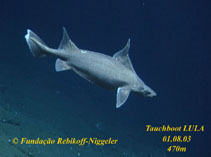Upload your photos and videos
Pictures | Google imageOxynotus paradoxus
Picture by Fundação Rebikoff-Niggeler
Pictures | Google imageOxynotus paradoxus
Picture by Fundação Rebikoff-Niggeler
United Kingdom country information
Common names:
Angular rough shark, Kite-fin shark, Sailfin rough shark
Occurrence: native
Salinity: marine
Abundance: common (usually seen) | Ref: Compagno, L.J.V., 1984
Importance: minor commercial | Ref:
Aquaculture: | Ref:
Regulations: | Ref:
Uses: no uses
Comments: Common on continental slope to the west of the British Isles below 200 m. One specimen found in coastal waters on Scourie Bank, S of Isle of Handa (Ref 5204).
National Checklist:
Country Information: https://www.cia.gov/library/publications/resources/the-world-factbook/geos/uk.html
National Fisheries Authority:
Occurrences: Occurrences Point map
Main Ref: Wheeler, A., 1992
National Database:
Occurrence: native
Salinity: marine
Abundance: common (usually seen) | Ref: Compagno, L.J.V., 1984
Importance: minor commercial | Ref:
Aquaculture: | Ref:
Regulations: | Ref:
Uses: no uses
Comments: Common on continental slope to the west of the British Isles below 200 m. One specimen found in coastal waters on Scourie Bank, S of Isle of Handa (Ref 5204).
National Checklist:
Country Information: https://www.cia.gov/library/publications/resources/the-world-factbook/geos/uk.html
National Fisheries Authority:
Occurrences: Occurrences Point map
Main Ref: Wheeler, A., 1992
National Database:
Common names from other countries
Classification / Names Common names | Synonyms | Catalog of Fishes(genus, species) | ITIS | CoL | WoRMS | Cloffa
Elasmobranchii (sharks and rays) > Squaliformes (Sleeper and dogfish sharks) > Oxynotidae (Rough sharks)
Etymology: Oxynotus: oxys (Gr.), sharp; notos (Gr.), back, referring to its keeled back (“dorso carenato”) (See ETYFish); paradoxus: Latin for strange or contrary to expectation; Frade was not sure if this shark, with its first dorsal spine directed backward instead of forward, represented a new species or an aberrant form of O. centrina (See ETYFish).
Etymology: Oxynotus: oxys (Gr.), sharp; notos (Gr.), back, referring to its keeled back (“dorso carenato”) (See ETYFish); paradoxus: Latin for strange or contrary to expectation; Frade was not sure if this shark, with its first dorsal spine directed backward instead of forward, represented a new species or an aberrant form of O. centrina (See ETYFish).
Environment: milieu / climate zone / depth range / distribution range Ecology
Marine; bathydemersal; depth range 265 - 1044 m (Ref. 128029). Deep-water; 41°N - 11°N, 13°W - 3°W (Ref. 54694)
Distribution Countries | FAO areas | Ecosystems | Occurrences | Point map | Introductions | Faunafri
Eastern Atlantic: Atlantic slope from Scotland to Senegal (Ref. 247).
Size / Weight / Age
Maturity: Lm ? range ? - ? cm
Max length : 120 cm TL male/unsexed; (Ref. 35388); common length : 85.0 cm TL male/unsexed; (Ref. )
Max length : 120 cm TL male/unsexed; (Ref. 35388); common length : 85.0 cm TL male/unsexed; (Ref. )
Found on the continental slope (Ref. 247; shallow depth from Ref. 35388. Probably feeds on small bottom invertebrates and fishes. Ovoviviparous.
Life cycle and mating behavior Maturity | Reproduction | Spawning | Eggs | Fecundity | Larvae
Distinct pairing with embrace (Ref. 205).
Main reference
Upload your references | References | Coordinator | Collaborators
Compagno, L.J.V., 1984. FAO Species Catalogue. Vol. 4. Sharks of the world. An annotated and illustrated catalogue of shark species known to date. Part 1 - Hexanchiformes to Lamniformes. FAO Fish. Synop. 125(4/1):1-249. Rome, FAO. (Ref. 247)
IUCN Red List Status (Ref. 130435: Version 2024-2)
Vulnerable (VU) (A2d); Date assessed: 31 August 2020
Threat to humans
Harmless
Human uses
Fisheries: minor commercial
FAO(Fisheries: production, species profile; publication : search) | FishSource | Sea Around Us
More information
Population dynamics
Growth parameters
Max. ages / sizes
Length-weight rel.
Length-length rel.
Length-frequencies
Mass conversion
Recruitment
Abundance
Growth parameters
Max. ages / sizes
Length-weight rel.
Length-length rel.
Length-frequencies
Mass conversion
Recruitment
Abundance
Life cycle
Reproduction
Maturity
Fecundity
Spawning
Spawning aggregations
Eggs
Egg development
Larvae
Larval dynamics
Reproduction
Maturity
Fecundity
Spawning
Spawning aggregations
Eggs
Egg development
Larvae
Larval dynamics
Physiology
Body composition
Nutrients
Oxygen consumption
Swimming type
Swimming speed
Visual pigments
Fish sound
Diseases & Parasites
Toxicity (LC50s)
Body composition
Nutrients
Oxygen consumption
Swimming type
Swimming speed
Visual pigments
Fish sound
Diseases & Parasites
Toxicity (LC50s)
Genetics
Genetics
Heterozygosity
Heritability
Genetics
Heterozygosity
Heritability
Human related
Aquaculture systems
Aquaculture profiles
Strains
Ciguatera cases
Stamps, coins, misc.
Aquaculture systems
Aquaculture profiles
Strains
Ciguatera cases
Stamps, coins, misc.
Tools
Bio-Quiz | E-book | Field guide | Identification keys | Length-frequency wizard | Life-history tool | Point map | Classification Tree
| Catch-MSY |
Special reports
Download XML
Internet sources
Aquatic Commons | BHL | Cloffa | Websites from users | Check FishWatcher | CISTI | Catalog of Fishes(genus, species) | DiscoverLife | ECOTOX | Faunafri | Fishtrace | GenBank(genome, nucleotide) | GloBI | GOBASE | | Google Books | Google Scholar | Google | IGFA World Record | MitoFish | National databases | Otolith Atlas of Taiwan Fishes | PubMed | Reef Life Survey | Scirus | SeaLifeBase | Tree of Life | Wikipedia(Go, Search) | World Records Freshwater Fishing | Zoobank | Zoological Record
Estimates based on models
Phylogenetic diversity index (Ref. 82804): PD50 = 0.5625 [Uniqueness, from 0.5 = low to 2.0 = high].
Bayesian length-weight: a=0.00372 (0.00163 - 0.00849), b=3.15 (2.94 - 3.36), in cm Total Length, based on LWR estimates for this (Sub)family-body shape (Ref. 93245).
Trophic level (Ref. 69278): 4.0 ±0.60 se; based on food items.
Resilience (Ref. 120179): Low, minimum population doubling time 4.5 - 14 years (Fec assumed to be <100).
Fishing Vulnerability (Ref. 59153): High to very high vulnerability (72 of 100).
Climate Vulnerability (Ref. 125649): Moderate vulnerability (36 of 100).




